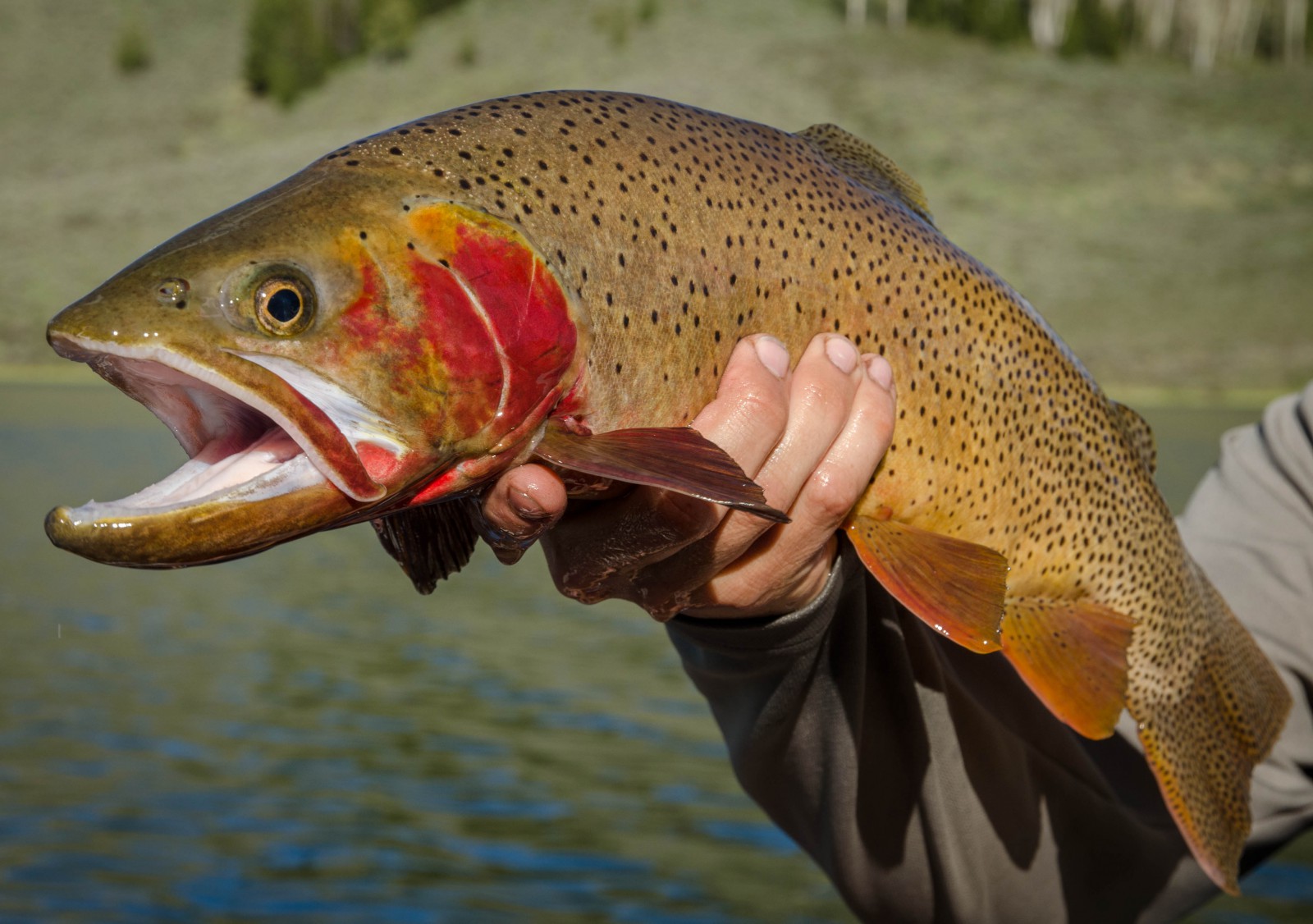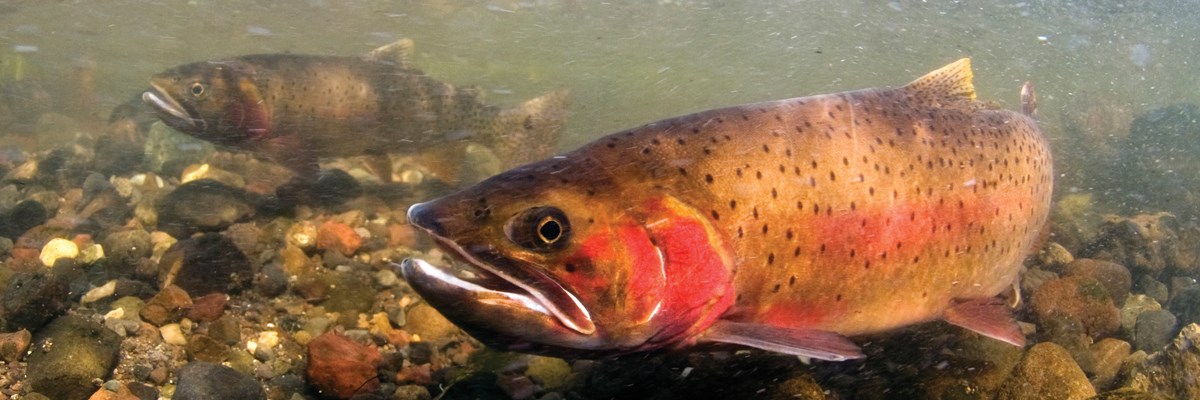Hunting and Fishing News & Blog Articles
Yellowstone Cutthroat Trout Get New Help

Photo courtesy of Friends of the Teton River
Imperiled Yellowstone Cutthroat Trout are getting a helping hand with new strategies being developed by fisheries managers to control invasive predator species. Biologists from the Montana Fish, Wildlife and Parks division, working with federal scientists from Yellowstone National Park recently outlined new measures that are being taken to preserve the native trout. But some strategies being used are controversial.
As reported by the Lewiston Tribune, fishery biologists spoke to a packed crowd of about 70 people at an April meeting of the Magic City Fly Fishers. MWP official Mike Ruggles explained the history of the decline of Yellowstone Cutts, which implicated deliberate introduction of invasive stream dwelling species like Rainbow, Brown and Brook trout, in addition to voracious still water Lake Trout.
“That early era of raising hatchery fish to transplant non-natives led to the transportation of boxcar loads of brook trout, brown trout and rainbows across the West and eventually to Montana”, said Ruggles. “That’s because by 1864 the state had already enacted fishing rules that limited catches to hook and line only, banning all netting and trapping, which had severely depleted once plentiful native fisheries.”
“So what did we end up doing? We spread non-natives all over the place.”
Montana is home to two species of cutthroat trout: Westslope, which mostly occupy waters west of the Continental Divide with the exception of the Missouri River drainage; and Yellowstone, which once had its stronghold in Yellowstone Lake.
Cutthroat Trout (Oncorynchus Clarkii) are endemic to the Intermountain West, and are an inland adaptation of Rainbow trout (Oncorynchus Mykiss), which are native to the Pacific Rim, from California to Siberia. Rainbows in their original form are anadromous, with a life cycle that can include migration to the ocean from fresh water spawning grounds, which results in the Steelhead variant of the species. Cutththroats can express anadromous behavior as well, with “Sea-run” Cutts being a prized catch in the Northwest. However, in closed inland freshwater ecosystems, effortless interbreeding between the species causes the dominant Rainbow traits to revert any Cutthroat progeny to their original form. In the case of the Yellowstone Cutthroat, this has been devastating to their genetic integrity.
Fisheries officials in both Montana and Yellowstone are now taking action to reduce invasive species through direct capture and the more controversial poisoning of streams, with an intent of restocking with hatchery raised native Cutthroat. Environmental advocates have raised concerns that short half-life poisons like Rotenone, which cause fish mortality through oxygen uptake failure via gill tissue inflammation, also affect benthic macroinvertibrates, the insects living in stream bottoms — which also respire via gill structures. Wipe out the insects in a stream, and the consequences to associated predator species within ecological webs are fairly obvious, despite the ability of flying insects to repopulate local watersheds within relatively short timeframes.
Yellowstone Lake, once a stronghold for the Yellowstone Cutthroat, presents its own set of challenges in restoring natives. Lake Trout (Salvinius Namaycush), related to Brook Trout and originally from eastern Canada, have become apex predators in the lake. Growing to 50lbs, Lake Trout are almost exclusively carnivores as adults, and can eat over 40 mature Cutthroat in a year that otherwise would be candidates for spring spawning and contribution to the gene pool.
Coverage from the Tribune continues, stating that, “Netting has been the main means to remove lake trout from the water body. In 2017, more than 5,700 miles of gillnet were set, Doepke said, enough to reach from Billings to Washington, D.C., back to Oakland, Calif., and back to Billings. The nets were set by six different commercial boats working six days a week at a cost of about $1.5 million a season, which runs from May to September.”

Photo courtesy of NPS.gov
“Last year, 397,000 lake trout were caught, but most of the fish were 8 to 12 inches long. Since 2013, when more than 400,000 pounds of biomass was netted, crews have seen that number fall to below 300,000.”
While Yellowstone Lake has enacted regulations specifically addressing Lake Trout, with mandatory killing of any of the species caught, the netting program has still apparently fallen short of the goals of the Park. A new strategy has been developed to halt the reproduction of the Lake Trout, with tagging of mature specimens used to identify spawning beds in the lake. Once biologists found the beds, they discovered that introducing the carcass of a large dead fish could discourage the use of the area by spawning fish, probably in response to perceived putrefaction /bacterial contamination of the site. In response to this discovery, a pellet-type agent was developed with the chemical signature of the rotting fish that is being reported as even more effective at discouraging spawning. It is unknown if the pellet agent presents any additional concern to environmentalists.
Other states have adopted alternative measures to deal with invasive species in lakes. In Colorado and New Mexico, the introduction of Tiger Muskie to lakes with too many rough fish has alleviated many problems, and created viable sport fisheries in their own right. Tiger Muskie — a sterile product of the forced hatchery crossbreeding between Pike and Muskellunge (much like a mule), are eating machines that can potentially grow to the size of large Lake Trout, but without the overpopulation problem. Of course, Tiger Muskie are not selective in what they eat, and both juvenile Cutthroat and Lake Trout would be at risk from any introduction of the control fish.
Management of native species is a thorny issue that will require 21st century thinking and solutions to problems that were largely created over 100 years earlier. Public education around the challenges that policy makers face can help reduce political friction, and ease the way forward for agreed use of tax dollars.
The post Yellowstone Cutthroat Trout Get New Help appeared first on Fly Fisherman.
Copyright
© Fly Fisherman

